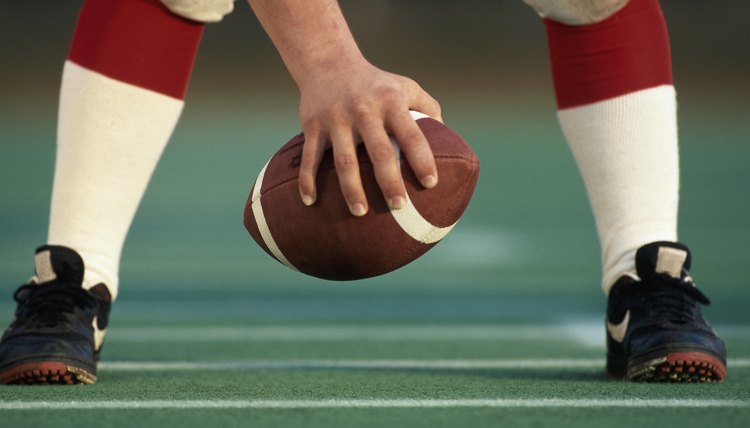Good Foods to Eat Before Football Practice

A football player doing two practices a day might need as many as 10,000 calories in one day. A player must eat before and after practice to maintain energy levels, weight and muscle mass. Selecting the right types of foods in the right combinations can help a player maintain his energy over the long term and give him the burst he needs right away. Some foods can upset a player's stomach if eaten before practice, so take note of any foods that affect a player poorly and try different combinations to find foods that work best.
Carbohydrates
Carbohydrates, especially those from fruits, vegetables and whole grains, are an essential component for a football player's diet. Before practice, eating a breakfast or snack rich in carbohydrates will give a player the constant energy required by the stop-and-go nature of playing football. The overall diet for a player should be almost 60 percent carbohydrate. According to Registered Dietician Leslie Bonci, a football player should look for carbohydrates in foods with less fat as well. Choosing a bagel instead of doughnut, mashed or baked potatoes instead of French fries and frozen yogurt over ice cream will give a player the necessary boost needed before practice without being dragged down by additional fats, which can be difficult to digest especially during times of high physical activity.
Protein
Protein is necessary for building muscle and for helping carbohydrates do their job. With a little protein in your system, along with carbohydrates, your body can make the energy from carbohydrates last a little longer. A football player needs about .7 to .8 grams of protein per pound of body weight each day -- the same as for the average person. Because football players require more carbohydrates in their diet than the average person, the actual percentage of protein recommended for them is lower than the average person eats. Bonci asserts that about 15 percent of a football player's total calories should come from protein sources.
Spread cream cheese, which has 3 grams of protein in 2 tablespoons, or peanut butter, which contains 8 grams in 2 tablespoons, on a bagel, or a have sub sandwich with lean ham -- 10 grams in three thin deli slices -- or turkey -- 5 grams in 1.2 ounces -- on a whole-grain role for a protein-filled snack. Choose a smaller piece of steak or chicken and pair it with vegetables and a baked potato. Add some protein to breakfast by eating a couple of eggs with whole-grain toast and fruit. Avoid bacon or sausage right before practice as it can drag you down. A piece of leaner ham or a sausage made from turkey, with its 23 grams of protein in 3.5 ounces, or chicken, which provides 14 grams in 3.5 ounces, provides the same flavor without the extra fat.
Fats
Fats and other nutrients are essential components of the football players diet, but it's important to get them from healthy sources. According to Bonci, 30 percent of a football player's diet should come from mostly unsaturated fat sources. Avoid fried foods before a practice like fries or chicken nuggets. A handful of nuts in a trail mix with dried fruit and dried cereals provides a good way to get extra energy from fat. Cubed avocado pieces in a salad or guacamole on a burrito are also good options. Fats are also needed to absorb vitamins E, A, K and D. The American Dietetic Association recommends that football players get .45 grams of fat per pound of body weight per day.
Hydration
Sports drinks are a good way to stay hydrated and keep carbohydrates in a player's system during practice. These drinks also have added sodium, which must be replaced if you lose a lot sweating during practice. According to Lehigh University, a football player can sweat at a rate of 10 liters per day. This can add up to a loss of almost 12 pounds depending on the size of the player. Those fluids must be replaced. Drink a 16-ounce sports drink at least two hours before practice and then drink throughout the practice and after. Water poured over a player's head or swished in his mouth and spit out does not increase hydration.
References
Writer Bio
Michelle Hogan is a writer and the author of 13 books including the 2005 bestselling memoir, "Without a Net: Middle Class and Homeless (With Kids) in America." Hogan studied English at American University and has been writing professionally since 1998. Her work has appeared in "The New York Times," "Redbook," "Family Circle" and many other publications.
